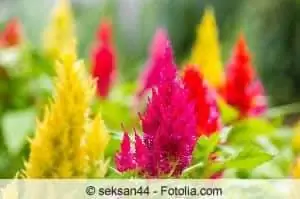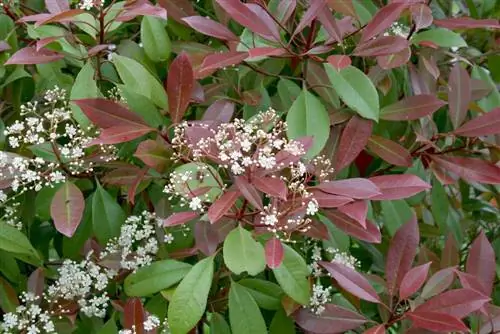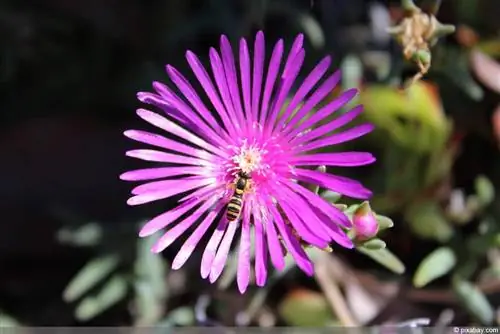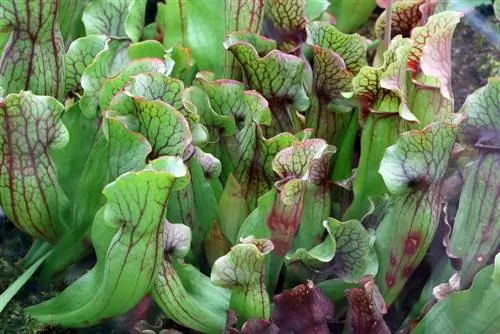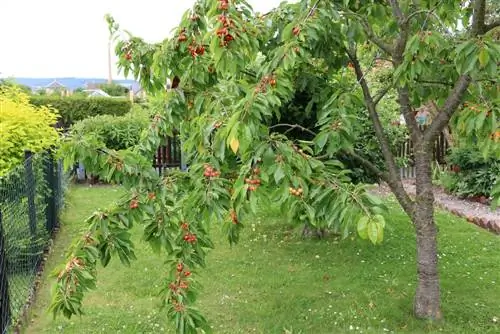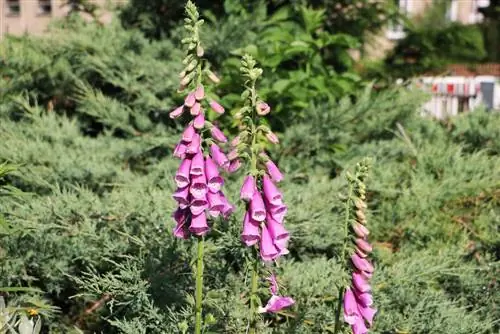- Author admin [email protected].
- Public 2023-12-17 03:39.
- Last modified 2025-01-24 12:45.
Pilgrims are so easy to grow from seed that they are popular stars at sowing competitions. After that, they are also extremely easy to care for, can be found in many different varieties of Celosia argentea and other types and can decorate balconies and garden beds, can be overwintered frost-free, can be eaten as vegetables and used as kitchen spices - the Celosia are a still relatively undiscovered genus of plants that have a lot more to offer. can" than she is usually given credit for:
The special thing about the Celosia: A deformity becomes a bestseller
When a particular plant becomes particularly popular on store shelves, there is usually a reason: it blooms particularly beautifully or for a particularly long time, is particularly robust or particularly easy to grow, etc. The particular popularity of the Celosia is based on a particularly pretty flower, but this is actually an abnormal deformity. The fireclaw has been an extremely popular ornamental plant in our country since at least the beginning of the 20th century, and behind this popularity there is a truly amazing story: When breeders attempted to breed the Indian variation of Celosia argentea var. A celosia with a very strange flower emerged - instead of the normal, upright flower candle, it had a strange, curled band of flowers.
The breeder was thrilled and named this firecracker C. argentea var others developed. Today there are flat and high cockscombs, folded and curled, white, yellow, orange, blood red, purple, violet and colorfully patterned. The malformation is probably due to overnutrition, the plant cells that are too well supplied no longer build the shoot normally, but instead develop a kind of fatty tumor, why this is also beautifully colored has not yet been researched.
The types of firecrackers
These best-known smuts, the silver smuts Celosia argentea, have just been examined molecularly genetically and have gained some growth, which previously “operated” under its own name. Because they interbreed, they are now considered Celosia argentea:
-
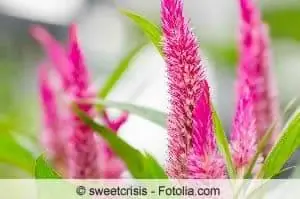
Firehead Celosia argentea var. argentea as a tropical primordial silver crested with 8-fold set of chromosomes
- Celosia argentea var. argentea as an Indian subspecies with four sets of chromosomes
- Celosia cristata (Celosia argentea var. cristata), cultivated form grown from the Indian subspecies
- Celosia plumosa (Celosia argentea var. plumosa), cultivated form grown from the Indian subspecies
- Celosia whitei, cross between the tropical original form and the Indian subspecies (or their descendants), 12-fold set of chromosomes
- Celosia argentea 'Caracas', well-known cultivar of Celosia argentea var. plumosa
- Celosia argentea 'Venezuela', well-known cultivar of Celosia argentea var. plumosa
Of all these celosias, there are many other cultivars that are usually referred to rather inaccurately unless you buy from a celosia specialist. There is probably no import nursery that specializes only in firecrackers. If you want to buy a specific Celosia argentea, you would have to look for a dealer who knows his stuff. There are several reasons for the gardener to buy a specific and not just any Celosia argentea, as the individual subspecies differ considerably in growth, appearance and benefits:
- Usually only a few “standard celosias” are offered in German stores
- Even when it comes to cultivated forms, there is a surprising variety of shapes and colors, in flowers and leaves
- You can get a nice selection of celosias, for example. E.g. view at parkseed.com/celosia/c/celosia
- The original “wild” Silver Coil grows almost two meters high and bears beautiful upright pink flower spikes
- The Indian subspecies starts branching right at its base, has broad leaves and is nowhere near as tall as the original form
- “var. cristata” develops a cockscomb, narrow, curled, meandering, banded
- “var. plumosa” has the original flower shape, colorful candles with many small flower spikes
Other Celosias
The Brandschopf genus has more to offer than just the Celosia argentea, this genus Foxtail family has developed dozens of species, several of which are used:
- Celosia nitida or texana, Indian cockscomb, rarely cultivated celosia from Central and South America, which is said to grow up to 2 m high
- Celosia palmeri, Palmer's Celosia, approx. one meter high and with magnificent flowers
- Celosia spicata, the pink to purple flowering spice celosia, grows as a widely branched perennial and is used as a soup and sauce spice
- Celosia trigyna, small perennial with funny flowers that hang in clusters at intervals on the stem
It is likely that more of the up to 60 species of Celosia are cultivated in their respective home regions and could at some point find their way into global trade.
Own cultivation: highly recommended for celosias
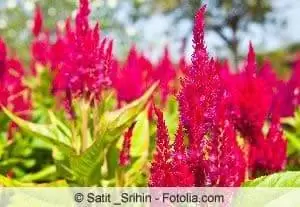
The silver colostrums can be grown so safely and easily from seeds and take such a short time to flower that many sowing competitions have already been won with a silver colostrum. That's why you can get seeds for Celosia argentea in spring in every garden center and even in many supermarkets; seeds of other species are available online. Sowing the firecrackers is so simple:
- Prepare cultivation pots with garden soil + sand or normal potting soil
- Spread the very fine brandy seeds well over the surface of the pot
- This works best if you mix the seeds with sand and sprinkle them loosely over them
- If you put a smooth tablecloth underneath, you can throw a little more generously
- Whatever went wrong is caught by the tablecloth
- This is poured into a bowl and then distributed again into the pots
- The scattered seeds are lightly covered with soil
- Growing pots are placed in a bright location at temperatures between 18 and 20° C, but without direct sun
- Keep evenly moist during the germination period (one to three weeks)
- When the seedlings are approx. 5 cm high, they can be planted in larger pots or balcony boxes
- They can be planted quite densely, individually in 12 cm pots, approx. 30 plants per m2 in the balcony box
- Only now can the young plants slowly get used to direct sunlight
- You can calculate in advance when the sea of flowers will appear, from sowing to flowering a celosia takes 10 - 12 weeks
Location and substrate
The firecrackers need bright and airy locations and can be cultivated at any temperature between 16 °C and 24 °C. A sunny location is generally good, but it can get too warm in the midday sun. If there is always a breeze on the balcony, direct sunlight usually doesn't do any harm. If the full midday sun hits the plant behind a window pane, light shading should be provided. Fireweed likes to grow in the garden bed over the summer. Since our summers usually only offer average temperatures at the lower limit of their temperature tolerance, in a location in full sun. The fireweeds may only be planted out when there is no longer any risk of late frosts, ideally not until the end of May, when the soil is already nice and warm. The firecrackers can be cultivated in any normal potting soil for flowering plants, in the garden in any bed with normal garden soil, nutrient-poor soil can be mixed with a little compost. Very nutrient-rich soil should be made a little less nutrient-rich by mixing in sand; firecrackers react more sensitively to over-fertilization than to a lack of nutrients. The bed should not be next to beds with other foxtail plants (spinach, chard, beetroot, amaranth, quinoa, garden foxtail, iresines), foxtail plants do not get along well with their relatives.
Caring for the Brandy
Caring for a burnt to the fullest satisfaction is pretty easy:
- Water evenly and regularly, rather too little than too much
- In nature, firecrackers grow primarily in wet African savannahs, which tend to be too dry rather than too wet
- You can and should always only add water when the soil on the surface has already dried out
- You hardly need to fertilize the celosias, purchased potting soil is usually already pre-fertilized
- The firecrackers can even react sensitively to increased s alt content in the soil
- If you supply Celosia with liquid fertilizer without soil analysis and precise calculation, you should proceed very cautiously
- Celosias in nutrient-poor soils are fertilized with a little liquid fertilizer, mixed in low concentration into the irrigation water
- The fertilizer should have an NPK ratio of 3/1/5 (3 parts nitrogen / 1 part phosphorus / 5 parts potassium=potassium-rich fertilizer)
- You don't have to cut celosias, but you can, the celosias are good cut flowers and dried flowers
- If you continually remove spent stems, the flowering period can last until late autumn
Overwintering and propagation
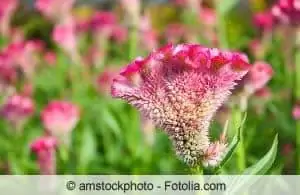
Purples are usually sold as annual summer flowers, but are actually perennials that just can't survive the winter here. From around 5 degrees plus it becomes too cold for the tropical plant, but at warmer temperatures you can hibernate. Exactly at what temperatures is controversial; it is usually recommended to overwinter celosias in a dark place and with severely limited supplies (real rest period). Others advise cultivating celosias at warm temperatures from 18 °C, in a bright winter quarter with the highest possible humidity (bathroom, kitchen, or spray regularly), without fertilizer, and with very little water. There are no reports of successful overwintering, only one negative report that overwintering at 16°C didn't work, so you would have to try it out yourself to see what your firecracker can survive.
All celosias are easy to grow from seed, but not all celosias produce many seeds. If you would like to obtain seeds from your own firecrackers for propagation, you have to pay attention to the most common celosias on the market (C. argentea var. cristata or var. plumosa, especially in the well-known cultivars 'Caracas' and 'Venezuela'). Be prepared to harvest very few seeds. These seeds could then also produce surprising results, as cockscomb is partly a genetically recessive trait and the flowers of the next generation could look completely different. What makes breeding experiments with firecrackers so exciting is that the original, wild celosia produce lots of seeds, but always the same offspring. Cocktails should also be able to be propagated through cuttings, but this is not entirely uncomplicated. In commercial plant production, the cuttings are artificially lit, covered with foil, treated with compressing agents and sprayed against fungi.
Celosias can be eaten
Celosia argentea var. argentea in its tall wild form and African species such as Celosia trigyna are grown as food plants and used as spices in Nigeria, Benin, Congo and Indonesia. Celosia is valued as a good alternative to amaranth because it produces higher yields and is resistant to pests and diseases. A recent study even demonstrated that Celosia argentea actively keeps weeds out of fields (root parasites of the Striga genus were kept away when the common sow plant was interplanted, and the yield of grain and sorghum was significantly increased). The silver smut is the most common leafy vegetable in southern Nigeria; young stems and flowers can also be eaten. In their home countries, other species are also picked and eaten; all celosias are said to be edible. Names such as Lagos spinach and “soko yokoto” (vegetable that makes husbands fat and happy) indicate the popularity of Celosia argentea as a food crop. Brandschopf leaves contain vitamin C, carotenoids and a little protein, are prepared in the native regions with hot pepper and chili, garlic and fresh lime as a side dish, but can also be prepared like classic spinach.
Conclusion
The firecracker is a plant that is as easy to care for as it is decorative and exciting, not only as the diverse Celosia argentea, but also in other species of the genus Celosia. As if that wasn't enough, celosias are also predicted to have a great future as food because there is hardly a vegetable that requires less care than the herb, which is similar to amaranth.

